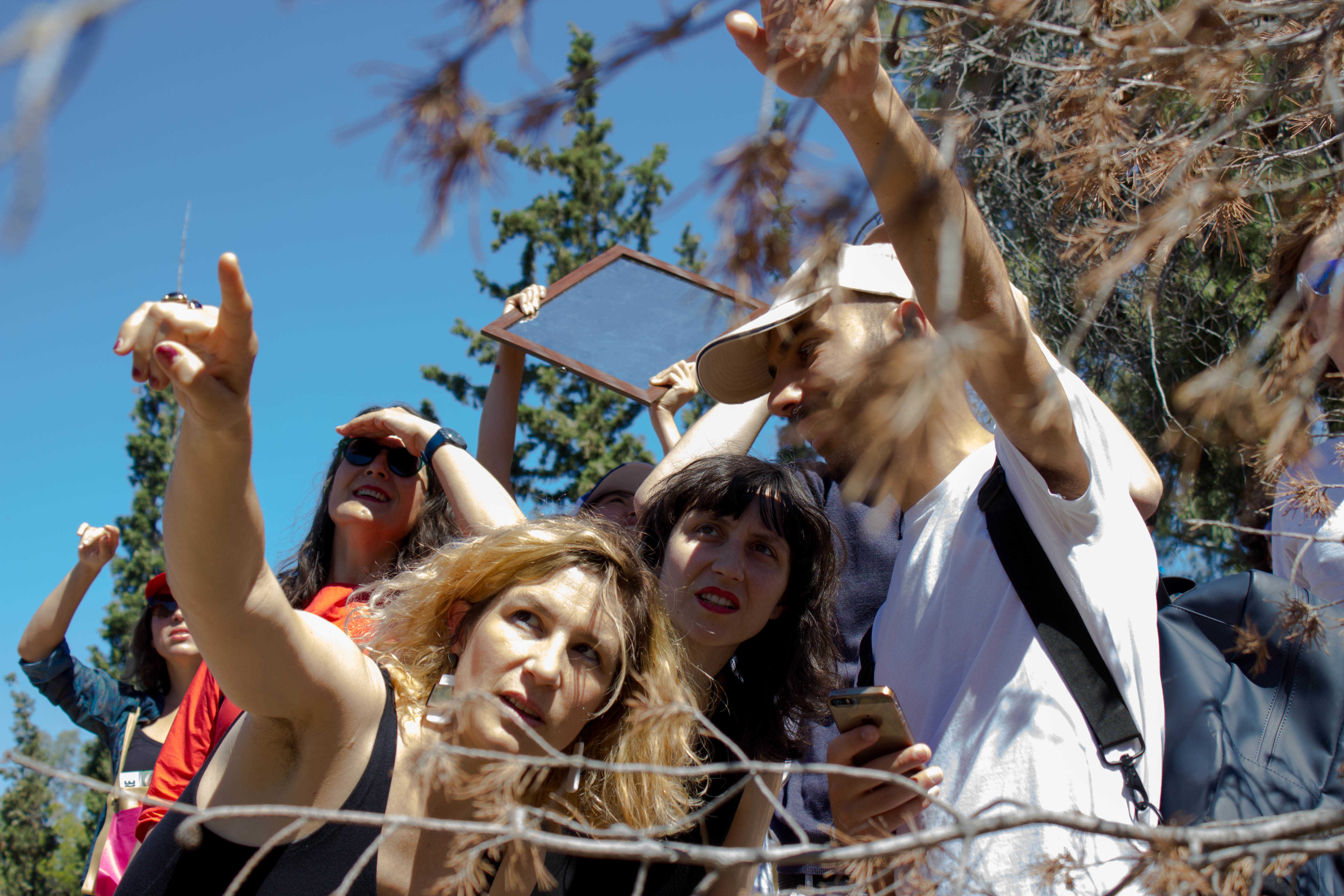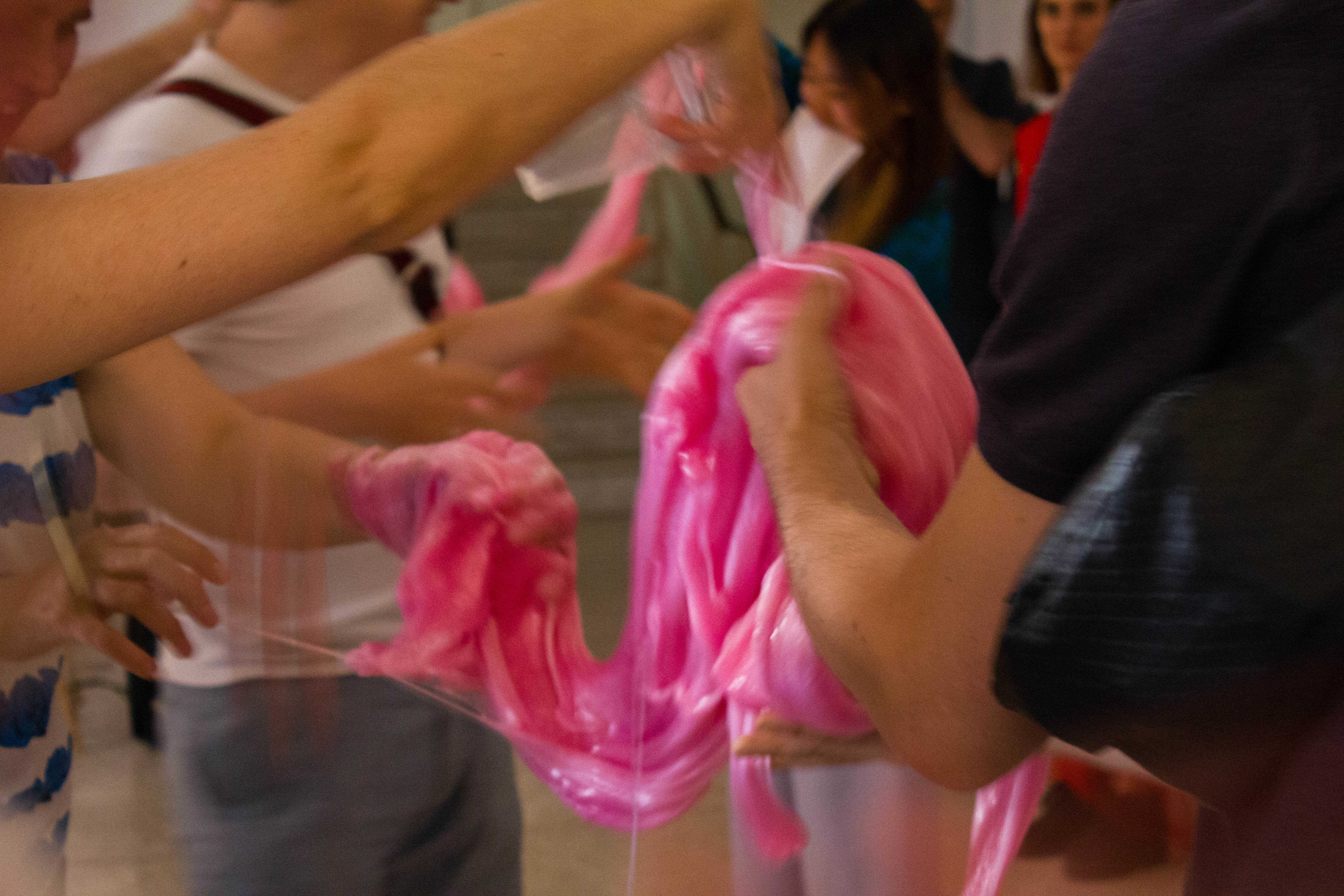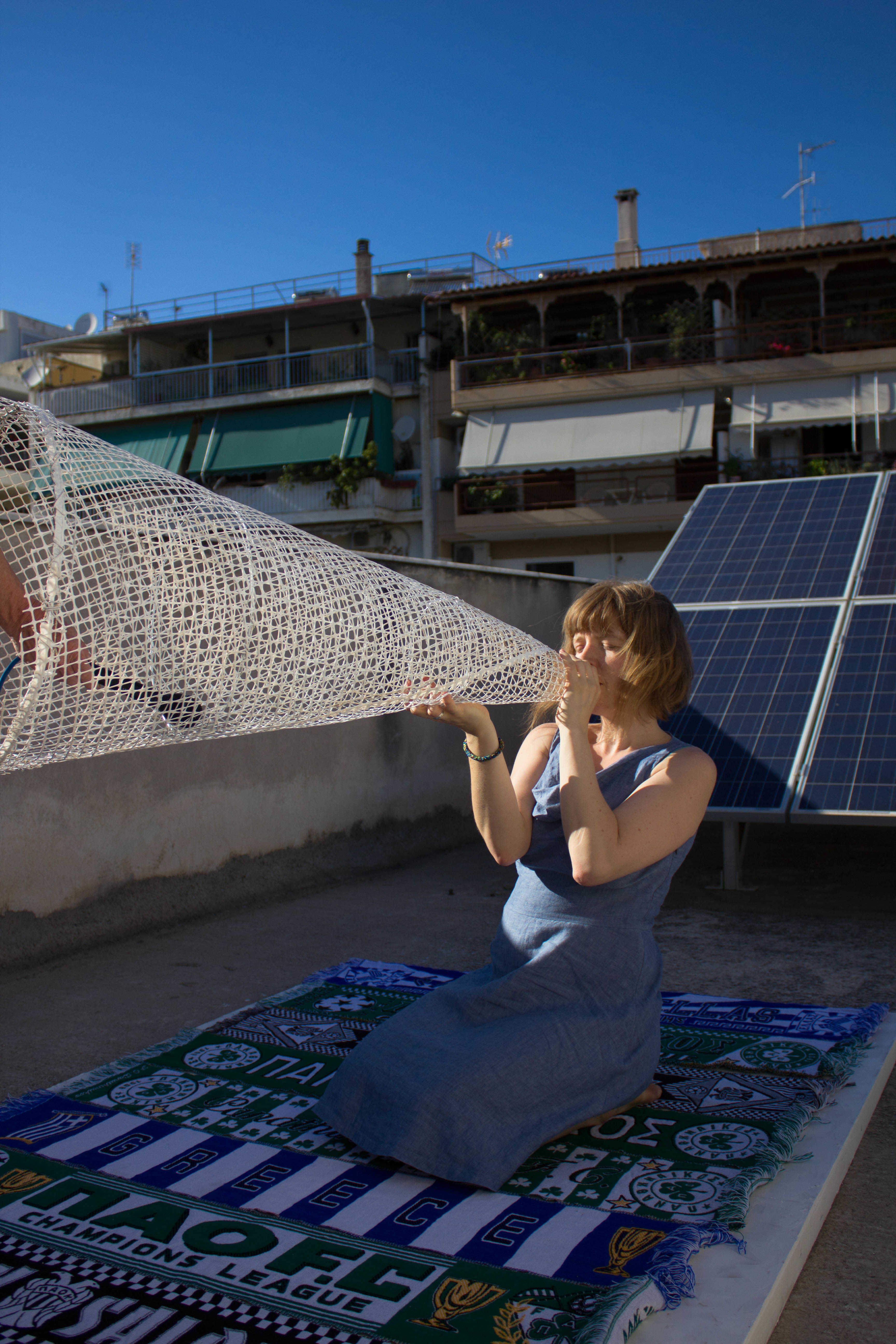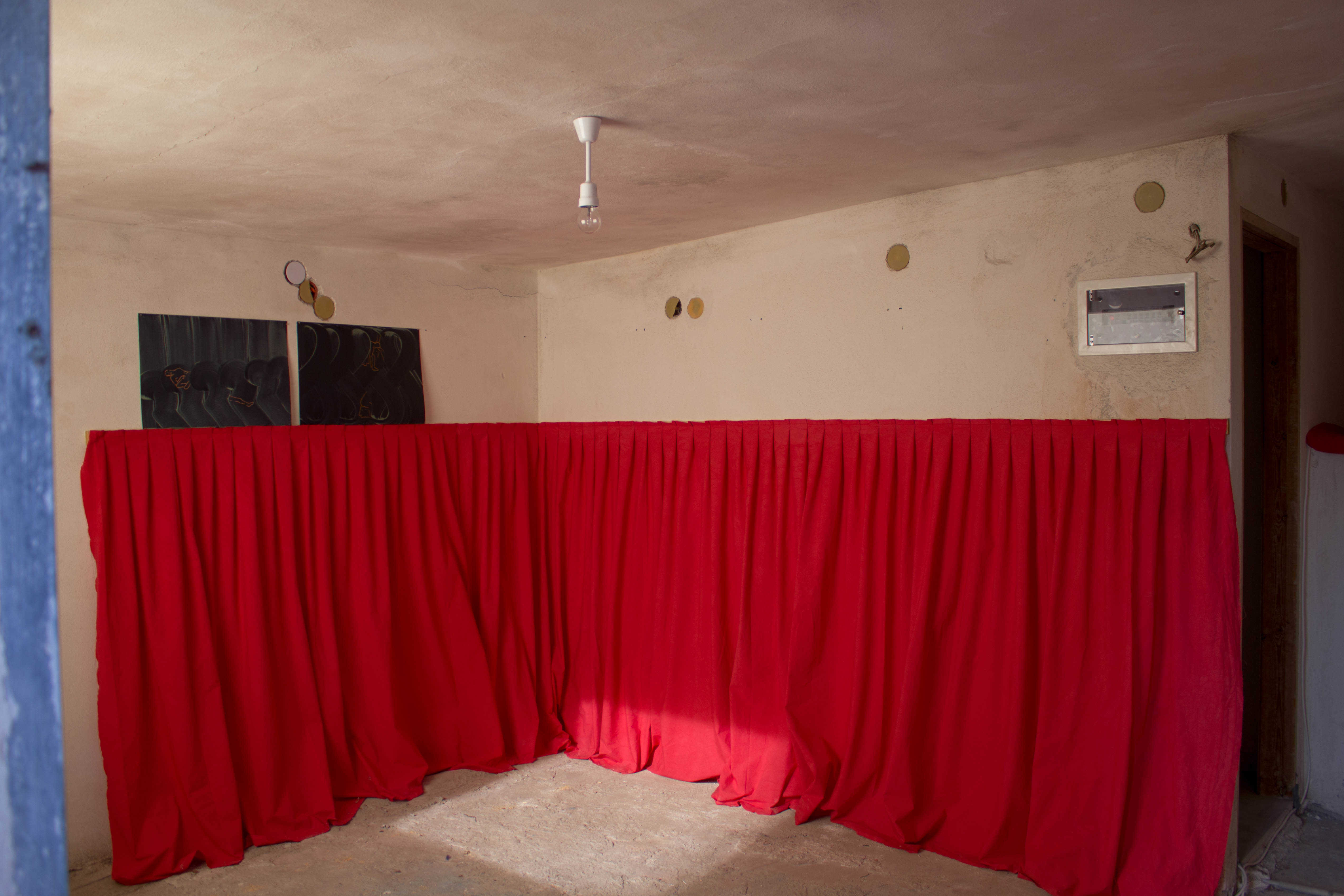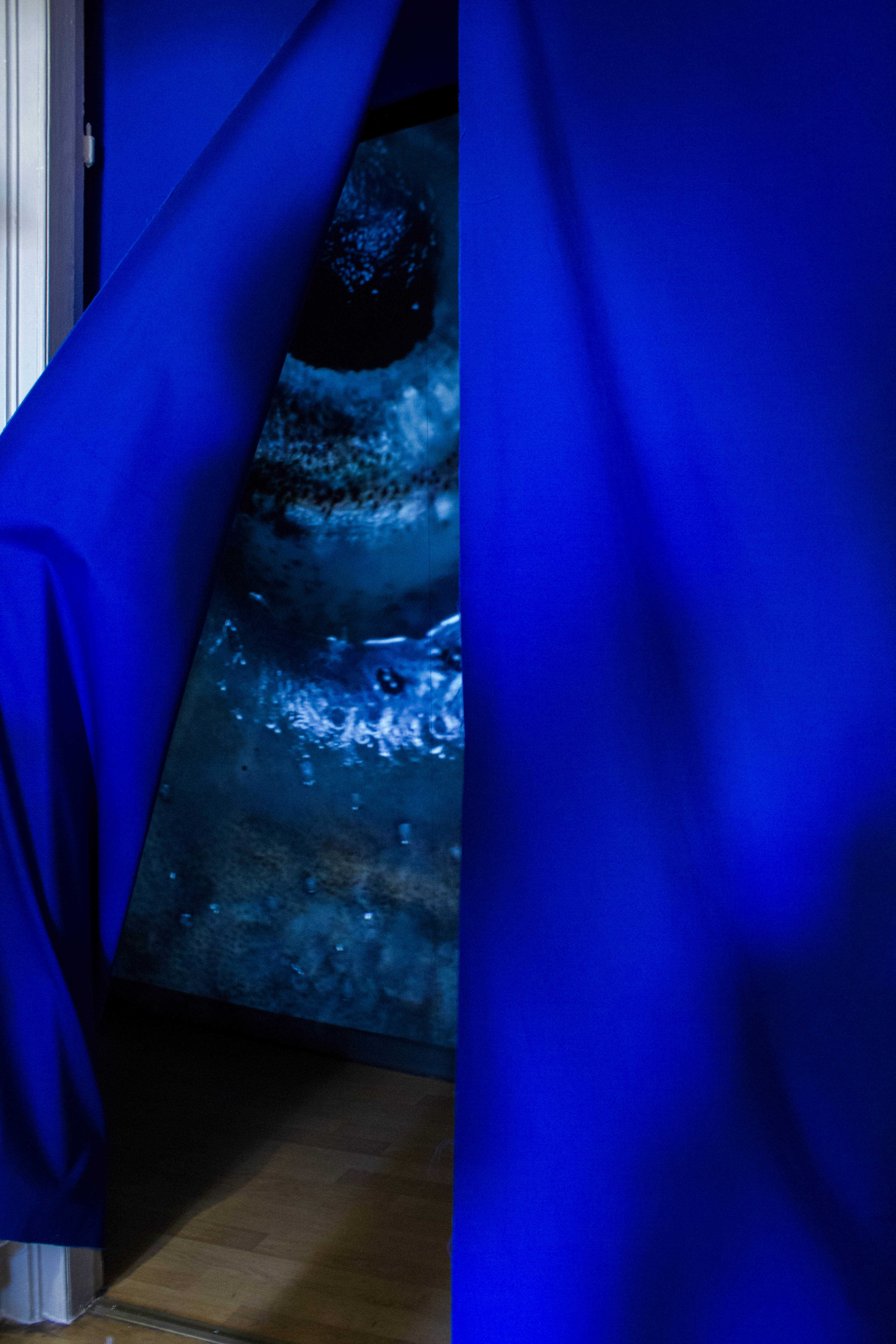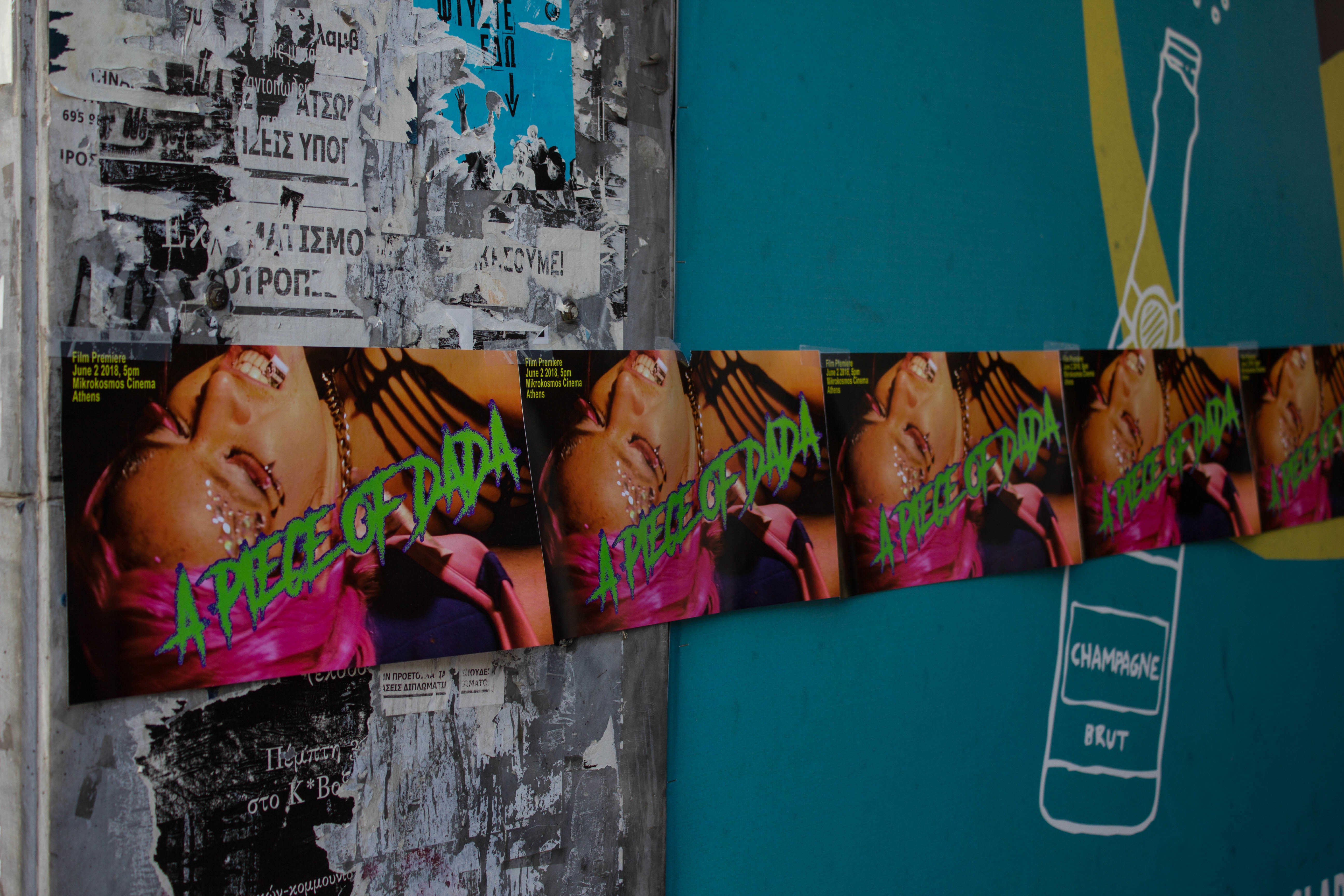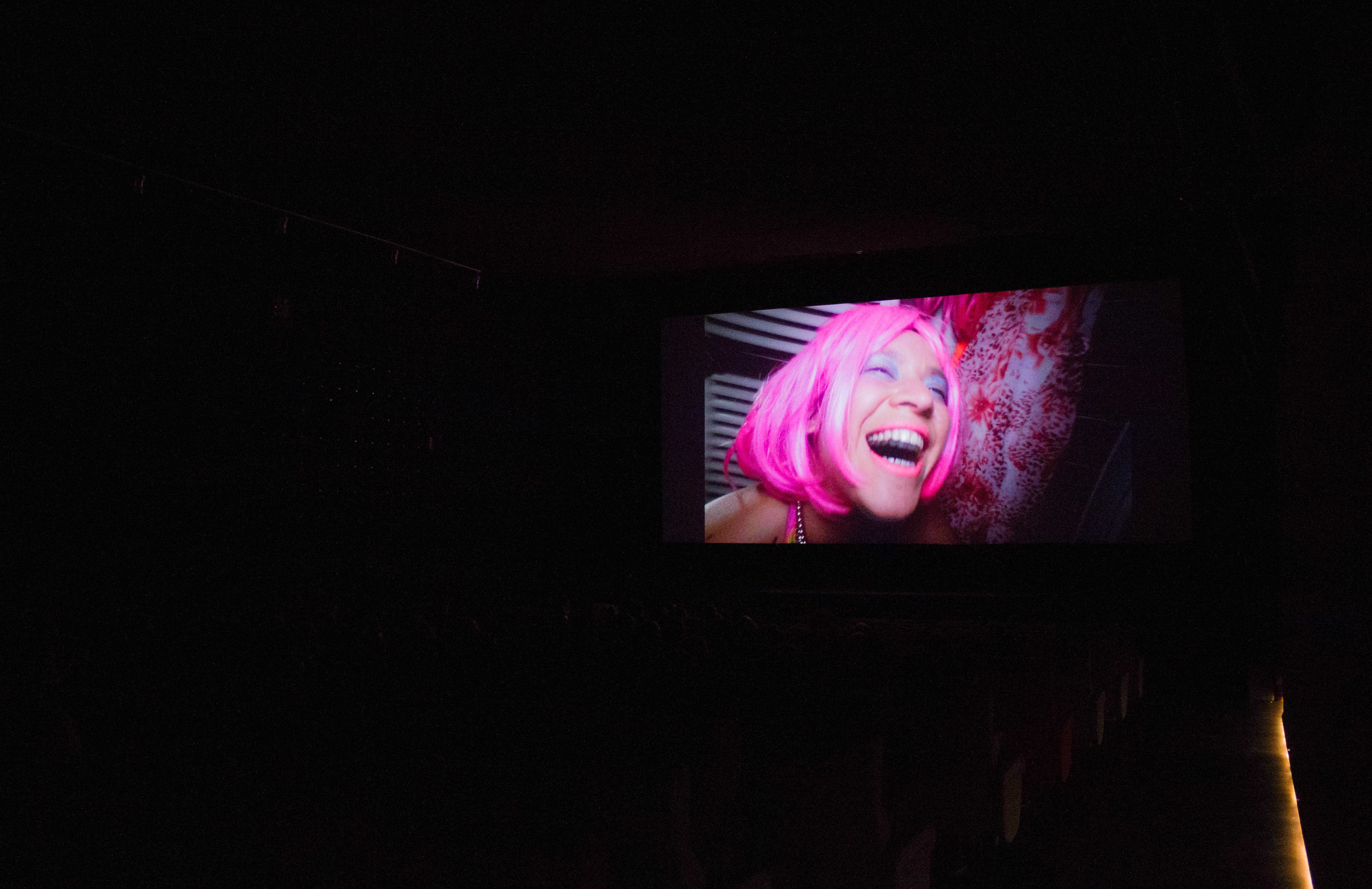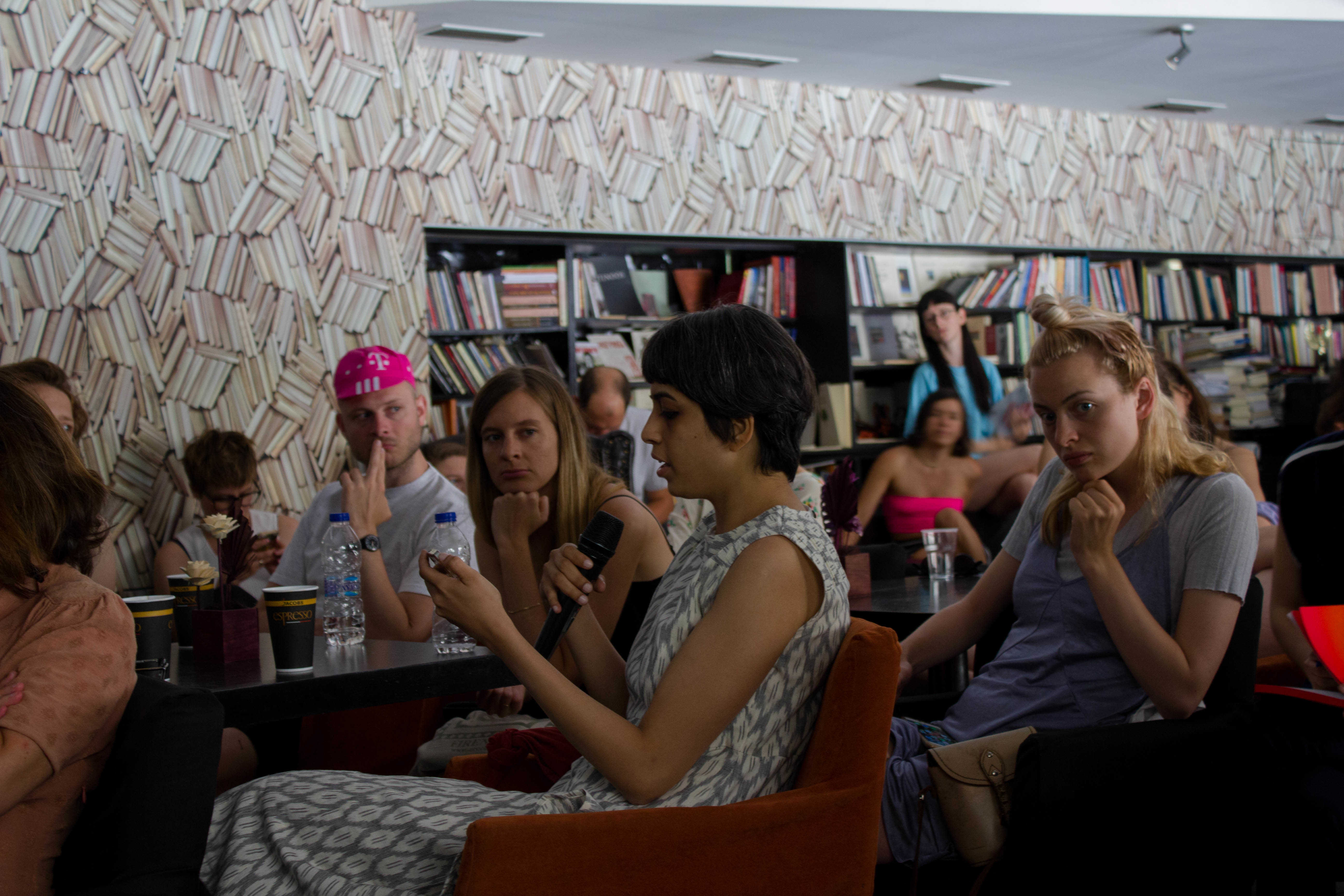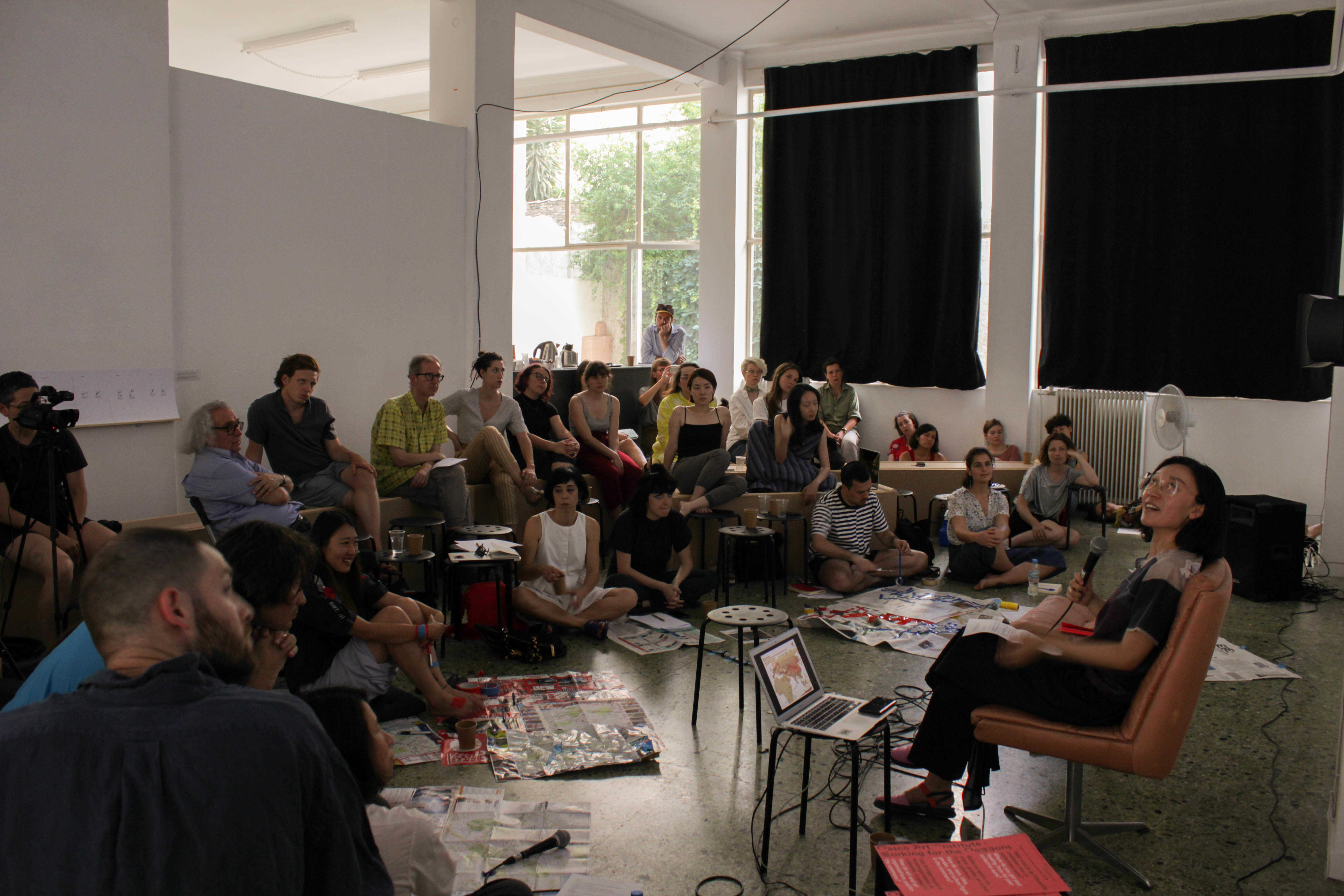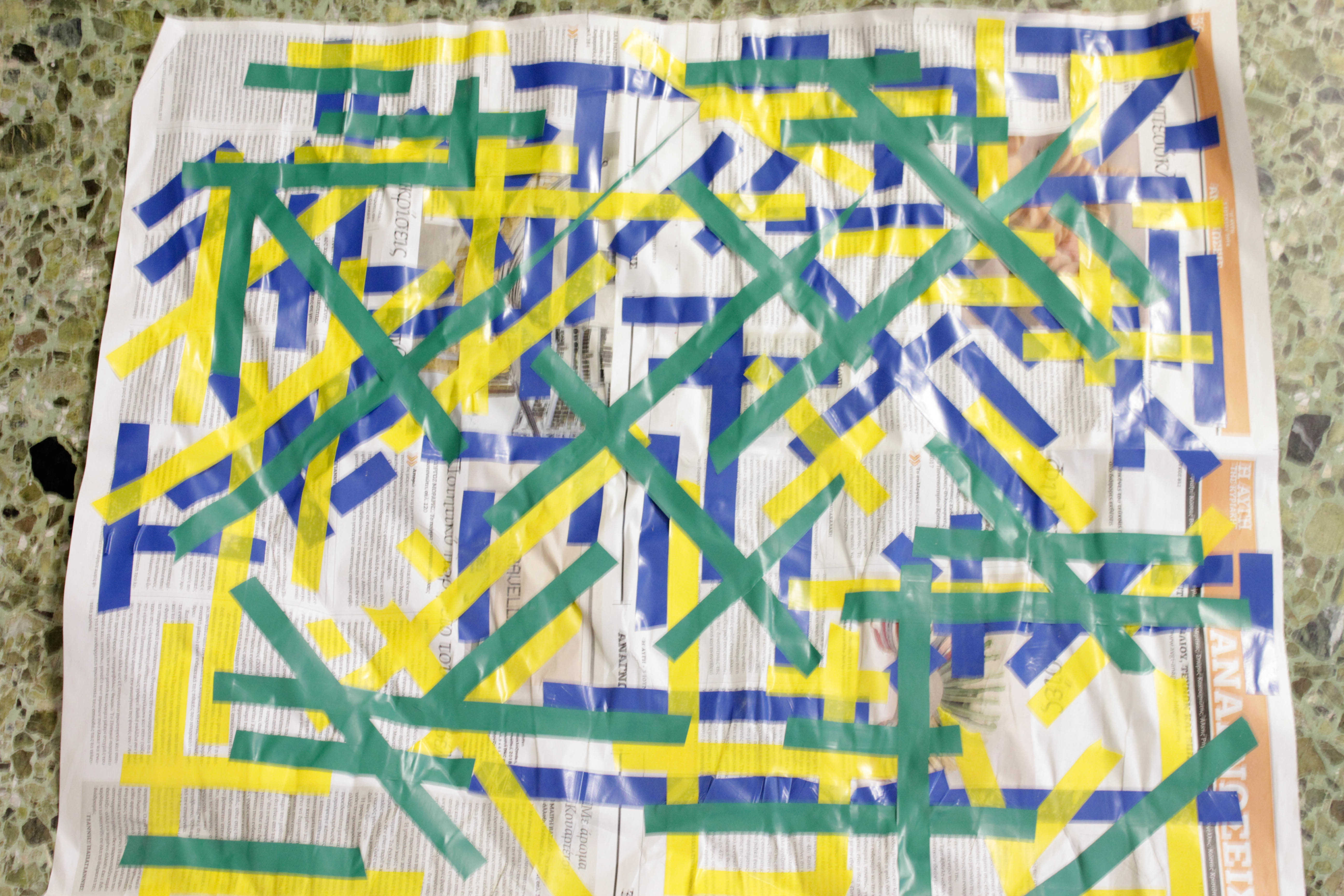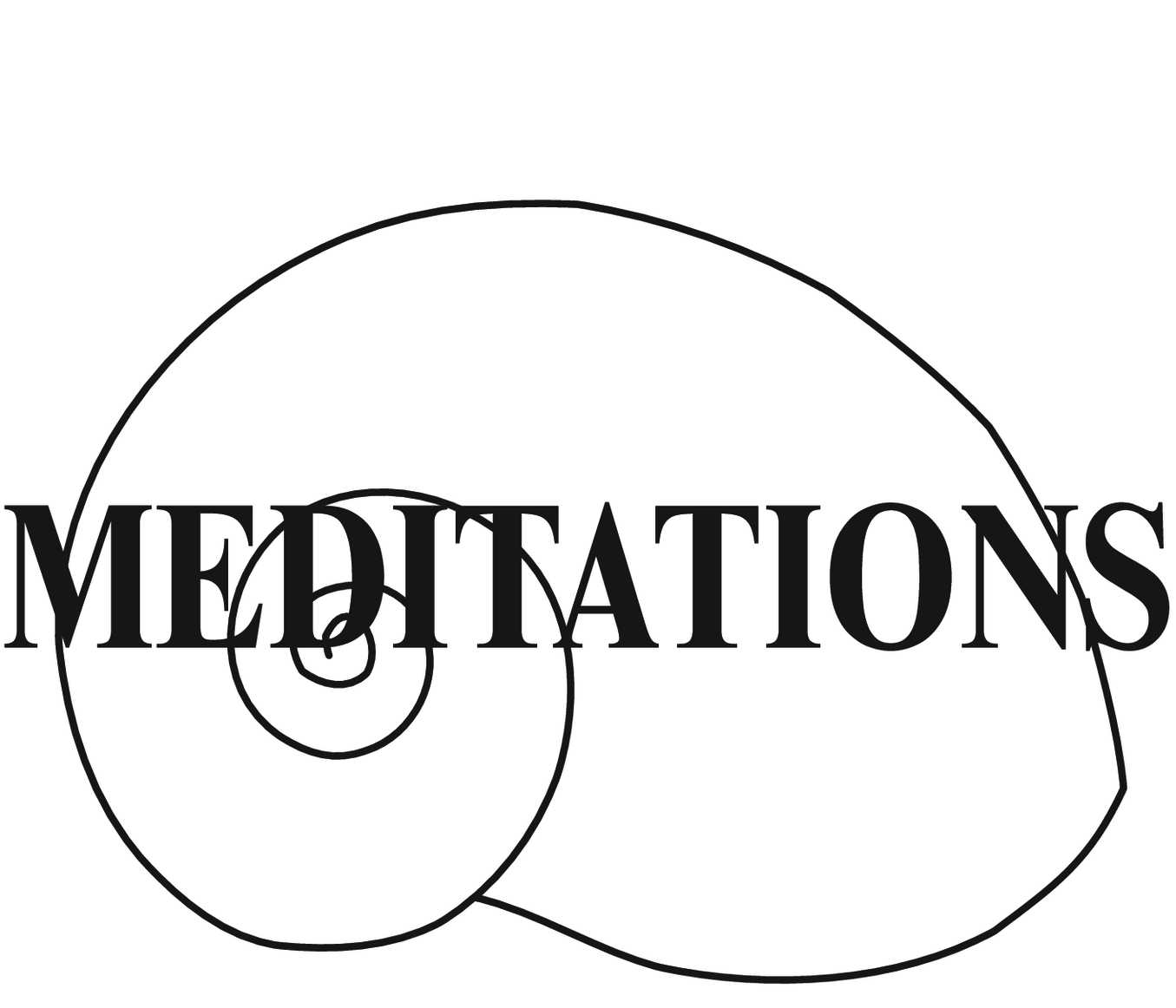2018 ~ Meditations #2 ~ You Mi
Dutch Art Institute has taken on a radical experiment – to become a roaming academy since the past academic year. Every month for one week, the DAI practitioners (sometimes it seems condescending to call them students) convene in a different European city, to work in one of the seven COOP Academy study-groups, along with partaking in theory sessions, workshops and one-on-one tutorials. After a year of intensive roaming in Arnhem, Cologne, Heemskerk, Oldebroek, Thessaloniki, Epen and Barcelona, the participants of the seven COOP study-groups landed in Athens. Higher education agencies in contemporary arts barely do enough to encourage collaborative processes, for the cross-pollination and contamination may promise much but return little. At DAI, this format of COOP Academy is an excellent case study of the various modes of collaboration and rehearsals of the relations between the one and the multiple.
The first group presentation took us on a walk up and down Neapoli, a hilly neighbourhood, curated by COOP group 'Curating Positions: Practising Organisation Under Present Conditions' (led by Marwa Arsanios, Emily Pethick and Leire Vergara) with ‘Islandthinking How to Co-Op(erate)?’ as title and guiding question. Through practicing organisation, the eight curators, artists and researchers have worked towards a commonality of interests and intentions, taking into account each member’s different background while exploring modes of being and working together on a roaming basis. A wonderful ritual seems to have developed out of this group: upon arriving in each city in the past months, one student took the rest of the group out for a walk, devising their own ways of relating to a place.
The presentations accompanied the walk in the neighborhood, stopping by gardens (and a mini amphitheater), narrow pathways, and residential houses. There were performance of visual poetry, reading of poetic-theoretical reflections on exchange and money, sound performance emanating from inside a house, and in the moment you least expected something to happen, you were flanked by personal readers who read a text for you on the move. The walk ended at the top of a hill, where a mirror was revealed to send signals by reflection to a house afar, on the top of another hill. At this moment, this multi-sensorial spatial-temporal displacement/connectivity that had been building up became palpable. I immediately associated this mirror message with a Calvino story, where two writers living on top of two hills overlooking each other kept speculating on and ended up writing the story the other person would write. This dynamism is perhaps not so far-off, as there is a heightened attention and genuine generosity toward the undertakings of each other – each ‘dividual’ – through which the group comes to life with contrapuntal but fully univocal positions.
"So often, we perceive places as dots spread out in space and our relation to them is one of connecting the dots by drawing a line."
One also gains a sense how the walking itself becomes a primary medium – the making of the line itself rather than connecting dots. On a philosophical level, this may be an apt answer to the question, ‘to roam or not to roam.’ So often, we perceive places as dots spread out in space and our relation to them is one of connecting the dots by drawing a line. The dots remain discrete entities and the lines subordinated to them. A different form of thinking can be posited as follows: the line, the movement itself, takes on the primacy and the dots are but temporary appearances and remain subjected to the lines. How to engender this pure movement seems to be key here.
The COOP group ‘Topologies of Touch’ (led by Florian Göttke, Marianna Maruyama and Jorinde Seijdel) took Circuits & Currents, the project space of the Athens School of Fine Arts, as a stage where multiple performances unfolded. We were welcomed by a desk of small and peculiar objects, the exchange of which was subject to a game-like rule, tactile entertainment of the sense with artisan bubble ice tea, and a vibrating sound performance induced by contact microphone. Moments later, after a reading of The Pink Goo Manifesto, a waterfall of pink gooey substance was poured from the second floor, forcibly implicating everyone into this pink universe, where the gooey, slimy yet resiliently consistent substance kept dripping down from whatever attempt to hold it. The heat in the space left one in a state of pre-human drifting, transpiring in the thickening air like a plant, or becoming part of a pink ectoderm continuum. If only all the works could synthesize more organically into a coordinated, tactile opera.
"Artist as nomads has become a trope, one that certainly has been reflected by the practitioners at the Roaming Academy."
The presentations of these two groups show a specific favoring of the performative format, one that is better suited for production on a roaming basis. Under this condition, the means of production, as well as the form-content have to be renegotiated accordingly. Artist as nomads has become a trope, one that certainly has been reflected by the practitioners at the Roaming Academy. The historical nomadic tribes perfected metallurgy to be able to carry metallic ornaments affixed to their attires, and to recast them as needed. They wove pictorial carpets or costumes to document epic stories or history as they didn’t keep written documents as they moved. This mode of production, however, has no eyes for individual artists. While being a nomad, how does an artist adequately relate to the locality and produce meaningful encounters while sustaining their own artistic practice? How do forms of the practice and forms of being together change with roaming? The group ‘Realty’ will be problematizing this later.
There are two exhibitions out of seven COOP groups, ‘Sleeping with a Vengeance, Dreaming of a Life’ (led by María Berríos, Tina Gverović, Ruth Noack) and ‘Practicing Articulation, Articulating Practice’ (Nick Aikens, Annie Fletcher, Navine G. Khan-Dossos). Though deliberately fleeting in the design of the theme, the materiality of the works and the spatial language of display do offer an important counterweight, an anchor and an abode, to the roaming horde.
‘Sleeping with a Vengeance, Dreaming of a Life’ is a cerebral and elegant exhibition curated by Ruth Noack with works of her students and invited artists. The political agency of dream is a potent topic, not least because of the multiple gazes and their political ramifications involved in it. Sleep can be a rejection to labor/productivity, but on the other hand, non-productive labor can be co-opted and mined for value. The subaltern can avenge in a dream (think Confession of an English Opium-Eater), but he can also be forever locked in perspectivism and denied of real emancipation.
"In retrospect, it’s possible to reconstruct the exhibition as if recalling a dream – indeed this could be the take-away of the exhibition, less as an exercise of the memory palace than practicing lucid dreams, in which one brings her own agency while dreaming and being aware that one is dreaming."
The exhibition is a poetic exposition that investigates these questions. Exquisite fabrics from the curator’s personal collection suspended in the ceilings gave a hint at the embracing gesture of the show. They also played foil to the paper works, toning the space even more for an intimate environment of discreet communications. Works punctuated the space, vacuum-sealed objects of waste bringing a speculative correlation between waste and dream, a print with the moon and the question ‘how long is the state going to last,’ recorded dreams of unemployed workers on CDs for sale, a personal note on a photograph of the artist’s father at sleep. They unfolded for the visitor as a rhythmic choreography, demanding different levels of attention while taken together they offer a warm embrace – indeed a reassuring feeling that one does not have to be armed with fanciful concepts to approach the works. The mattress tucked in the corner of a corridor extended the promise of the exhibition to the audience – everybody is welcome to sleep and dream there. In retrospect, it’s possible to reconstruct the exhibition as if recalling a dream – indeed this could be the take-away of the exhibition, less as an exercise of the memory palace than practicing lucid dreams, in which one brings her own agency while dreaming and being aware that one is dreaming.
‘Practicing Articulation, Articulating Practice’ took place in a young gallery called Hot Wheels. The word articulation has a double meaning in English. The first is to form, to put into words, to articulate something, or as Angela Davis calls it, ‘finding the words you do not yet have.’ Articulation also means the linking of different elements to form a joint, create a new unity.
"The word articulation has a double meaning in English. The first is to form, to put into words, to articulate something, or as Angela Davis calls it, ‘finding the words you do not yet have."
Motivated by the double-folded process of articulation, the exhibition featured seven artists translating form and thinking, while creating new connections to give meaning to things. Zoe Scoglio and Lucie Draai’s works individuated from their collective reading group dedicated to the Cannibalist Manifesto by Oswald de Andrade, one probing at the ‘spooky actions at a distance’ of quantum entanglement, the other speculating on the becoming planetary of the self through somatic exercises. Maya Watanabe’s film captured a crucian carp in biostasis, the state of an organism in which it suspends all its metabolic processes while remaining alive. Beautifully filmed under a synthesised condition in a 17th-century anatomical theatre, the film enacts a silent resistance to the biopolitical capture of life.
The group ‘OPERA CORRUPTION. On Tricks, Tricksters and Charms’ (led by Frederique Bergholtz, Pauline Curnier Jardin, Sara Giannini) presented a film as a collective work. Titled A Piece of Dada, it’s premised on the observation made by philosophers Slavoj Žižek and Mladen Dolar that opera dies in Europe with the invention of psychoanalysis. Throughout the year the group has looked and experienced the operatic voice as the locus of articulation and de-articulation of the collective unconscious, as the voice of the unspeakable.
Following Lady Dada, a celebrity performer who eats dollar bills and shits them too, the film has a deliberate B-movie feel with cheeky and excessive acting, yet conveying a kind of uncompromising passion that adorns corruption, money and desire while deconstructing them. In hindsight, perhaps it is not just the invention of psychoanalysis that announces the death of opera, but the acceleration of capitalism, itself embodying desire for desire or the auto-production of desire, that finds a new outlet for the unsurmountable passion once harboured in opera. Hence fetishism around bodies with perverted desires prevailed the urban life of interwar Europe. In Japan, it’s known as hentai. This fetishism also found new alliances with opera. With the current economic recession (more felt in Athens than in northern Europe), and a string of centennials underway – of the first world war, of the Dada movement, et cetera, A Piece of Dada is a timely tribute that refocuses our attention on money/capitalism, desire and fetishism.
On top of the undertaking of resurrecting opera, the film format arguably demands an industrial production pipeline and intensive, coordinated teamwork. The participants had to cope with the one-week-per-month roaming schedule and managed to shoot when they were in Barcelona. With it, this COOP group offers another possibility to artistic collaboration.
"With the current economic recession (more felt in Athens than in northern Europe), and a string of centennials underway – of the first world war, of the Dada movement, et cetera, A Piece of Dada is a timely tribute that refocuses our attention on money/capitalism, desire and fetishism."
Given the extravaganza mode of performance which rather befits the Dada opera-film, it does seem that there is a pressure to perform in a group setting. The group ‘Realty’ comes up with a formally different answer to this: their performance demonstrates that performativity can be situated in the discursive too. (Also: it’s important to find a mode of performing without feeling embarrassed.)
The COOP group ‘Realty’ (led by Rachel O’Reilly, Katya Sander, Tirdad Zolghadr) focuses on the role of Contemporary Art in recent histories of urban development and gentrification, and by extension, addresses the issue of how to relate to a locality and how to position oneself as a practicing artist while roaming. The students from the group staged a show trial, in which real and abstract agents such as ‘contemporary art,’ ‘the brick’ and ‘real estate’ took turns to speak. The debate turned around how artists are implicated in gentrification in a concrete case in Athens and in the contemporary art ecology in general. The show trial, a format that promises both formal performativity and wry jokes – usually insider ones that precarious artists know all too well, merged into by a general assembly by a slight-of-hand transition. The floor opened to the sixty DAI students and tutors, some expressed their concerns for repeating the same logic while trying to critique it, some rather saw the benefits of the contacts and contaminations taking place while roaming.
Sometimes the reality is more real than can be theorised. The stark consequences of the austerity measures were felt when we, in transit between the sites, observed one attempted theft at the metro, and moments later, the bag of our own colleague was stolen. But you also learn from the locals not to go to the police about the theft if you catch the young Roman girl, as it might only do more harm to her. You could feel your body getting tense and you subconsciously clutching your tote bag tightly. There is a life outside of the arts.
Hardt and Negri latest book Assembly looks into organisational models and types of institutions of the new left, of which the Occupy is emblematic. For them, what begins as a coalition must undergo a sea change and assemble as a multitude of powerful new subjectivities. And the multifarious and syncretic multitude must be self-critical and attain consciousness of its shared condition. (Hardt and Negri 2017) In this sense, the general assembly format can and should help each participant rehearse and realise the multiplicity in one self. At the same time, it must be directed at a collective process of self-transformation. One has the feeling that ten years after their trilogy of Empire (2000), Multitude (2004), and Commonwealth (2009), there is a shift of attention to form and methodology, whereas the pressing questions still remain to be solved.
"Sometimes the reality is more real than can be theorised."
The search for the right conditions to sustain one’s artistic/life is a noble cause, and for sure DAI Roaming Academy affords a place for reflection. Marina Vishmidt, who has taught theory seminars at DAI until the end of this academic year, and her co-author Kerstin Stakemeier call out for ‘an understanding of autonomy that seeks to undercut capitalist identifications with the individuations that traverse them. A denaturalisation of the subjects and objects of capitalism and an understanding of speculation that does not mimic the idealistic structure of capital, as it is characterised in the figure of value as automatic subject, but which emanates from an understanding that both alienation and autonomy are implicated in the relations of human life to the capitalist machinery which lies at the core of the reproduction of that life.’ (Stakemeier and Vishmidt 2016, 60) The meta-condition of the production system calls for reconsideration, but just as much attention should be allocated to the need to de-sync one’s own desire to that of the capitalist machinery, which operates on an affective level, and to delink the need to individuality whose desire is constantly modulated by capitalist affectivity. In this sense, the community may truly become a ‘coming community’ if they place premium not on production, but question reproduction on a collective level.
Interestingly, the group ‘Proximity Aesthetics: Constructing New Ecologies of Practice’ (led by Bassam El Baroni, Diakron, Luke Pendrell) also attempts to address the systemic problematics in the arts. They have been actively engaged with ‘methodologies, and approaches that aim at transforming the notion of artistic research into that of contributory research,’ in a way that set actual interventions and change processes in motion. They define proximity aesthetics as redefining the proximity-relation between art practice, artistic competencies, and research on the one hand and a plethora of issues concerning institutional infrastructures, financialisation, site specificity, and the adjoining of life, art, and technology on the other.
"For the becoming ‘creative’ of everything under neoliberalism should not efface art but all the more demand sharpened positioning of the arts."
The presentation aptly takes places on a collectively constructed website, where debates, readings and speculative knowledge are shared. The most telling case of how this proximity practice can be put to work is seen in the initiative Diakron, a Copenhagen-based collective who acted as tutors in the COOP group. One of Diakron’s projects is a platform of artistic and organisational development inserted into the headquarters of Aquaporin, a water technology company. Through artistic collaborations, display, transdisciplinary research, the initiative is dedicated to a new type of organisation that rethinks the relation between arts, sciences and industries. Dealing with systems which may easily give way to abstraction, the group especially made an effort to include affective elements such as story-telling, for example you can read about ‘indecent thinking by means of AI.’
We are living in an age where the Adornian autonomy of art is challenged by the fact that the speculative, open-ended and creative are increasingly appropriated to be structural elements of neoliberalism, most visibly in creative industries. At the same time, Vishmidt insightfully points out there is a shared speculative identity, or a structural analogy between art and finance, where the speculative practices of art, premised on its creativeness and open-endedness, and financial speculation as an intensification of capital’s self-perpetuation of future-oriented growth conjoin and reflect each other structurally. This can be seen not just in the replication of the capitalist market logic in the art market but also the rising demand for ‘creativity’ in the neoliberal labour market regardless of the nature of the work, and in social reproduction – coming up with ‘creative’ means of subsistence – at a time when social infrastructure becomes increasingly inadequate. (Vishmidt 2018)
In this sense, the ‘Proximity Aesthetics’ group tries to think how the institutional structure of art can reflect the changing socio-political and economic conditions by reforming the infrastructure of the arts, and by proposing art as a social infrastructure. For the becoming ‘creative’ of everything under neoliberalism should not efface art but all the more demand sharpened positioning of the arts.
How can we reconfigure our frame of thinking, from the front-end to the back-end? Edel O’Reilly, one of the group members asks. This question is pertinent as much for politics and society as for the arts. In the political sense, it demands a different model than representational politics (however decentralised and digitalised) and questions the interactivity (if not interpassivity) in politics. In the arts, if we extrapolate this to the reflection on reproduction and see indeed there is also a front-end and back-end hierarchy, our attention is then attuned to and in solidarity with the reproductive labour, thus shifting the frame of value production from the conventional focus on production. What reproduction entails today is something artists could offer new ideas on, from the classical acts of maintenance, to perhaps a networked way of expanding consciousness.
Epilogue
The epilogue to the Roaming Summit was The Roaming Assembly #22 Eurasian Steps, another format that DAI adopts as part of its roaming program, and an occasion where DAI interfaces with the local context on discursive and artistic levels. In the Athens edition, Binna Choi and myself invited artists, curators and researchers to thematise the various historical, cultural Eurasian connections as well as geopolitical, economical projects under the Eurasian banner. The now Chinese-held Piraeus port just outside of Athens provided a perfect backdrop for reflection on supranational infrastructural projects such as the Chinese Belt and Road Initiative. Unpacking old and new imperialism, we may also find Russian Eurasianism, originally formed in Russia in the 1930s, which focused on geocultures and assigned value outside of Western cultural worlds. It anticipated later culturalist postcolonial discourses and, most alarmingly, the re-surfacing of the right-wing ‘Eurasian’ movement headed by Aleksandr Dugin and celebrating Russia’s expansionist agenda to build a Eurasian sphere of influence. Curator and artist Nikolay Smirnov’s current research on left-wing Eurasianism as a synthesis of Marxism and spirituality, social activism and aesthetic practice, provides valuable insight on how claims on Eurasianism can be sustained.
We have also invited the Athens-based art collective Kernel Operations to give a grounded picture of reality. They documented such an event of local residence in their work Bridge (2016), in which a perforated vinyl print depicting a 1:1 scale fragment of a black monochrome graffiti can be seen. The graffiti, signed by a certain ‘OFK,’ was painted recently throughout a transport railway bridge between two hills as a critical route connecting the port Piraeus to the interiors of Greece, as part of an infrastructure project backed by Chinese and American companies. On the inaugural ride, according to the driver of the train, the engine that pulled the thirty-eight container wagons of the train collided with an improvised barricade. No one claimed the sabotage on the railway. The artists climbed up the steep hill to reach the bridge and found the graffiti on the two sides of the railway bridge to their surprise. Months after they’ve opened the show in which the graffitis were reproduced, they received an email with only one line: ‘Why you climbed up that bridge?’ And signed ‘OFK.’
"Deep in the commons is the earth and the mind."
The conversation started and ended with the commons. What can a Eurasian commons be today? Speaking of the commons in our time refers to a complex endeavor of intervening into existing systems: questioning what they are for, by and for whom they are made, and negotiating between private ownership and public governance. While connected to democracy, it does not take for granted existing representative and hierarchical democratic systems and instead takes the front-end and back-end distinction to issue. Deep in the commons is the earth and the mind. In this light, Eurasia appears to be a historical backstage as well as an uncoordinated matrix for the commons. It’s a context where ideological strata and resonating national strata are drawn, but whose vastness and transversality from one end to another offers the possibility for other kinds of movements and conjuring activities.
These are the reflections and questions that we can take away, among other old and new lessons from Athens. With this in mind, the DAI Roaming Academy has embarked on a new academic year’s journey, and I look forward to more articulated modes of engagements on organisational, content and political levels.
June, 2018
Author: You Mi
Photos: Silvia Ulloa.
Notes:
Hardt, Michael, and Antonio Negri. 2017. Assembly. Oxford: Oxford University Press.
Stakemeier, Kerstin, and Marina Vishmidt. 2016. Reproducing Autonomy: Work, Money, Crisis and Contemporary Art. Berlin: Mute.
Vishmidt, Marina. 2018. Speculation as a Mode of Production: Aesthetics and the Financialisation of the Subject. Leiden: Brill.
More about the 2017-2018 COOP study groups:
Announcement + Program COOP SUMMIT 2018
COOP study group 'Curating Positions: Practising Organisation Under Present Conditions'
COOP study group ‘Topologies of Touch’
COOP study group ‘Sleeping with a Vengeance, Dreaming of a Life’
COOP study group ‘Practicing Articulation, Articulating Practice’
COOP study group ‘OPERA CORRUPTION. On Tricks, Tricksters and Charms’
COOP study group 'Proximity Aesthetics: Constructing New Ecologies of Practice'



